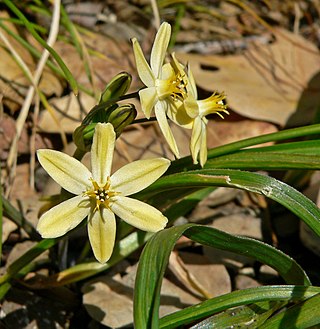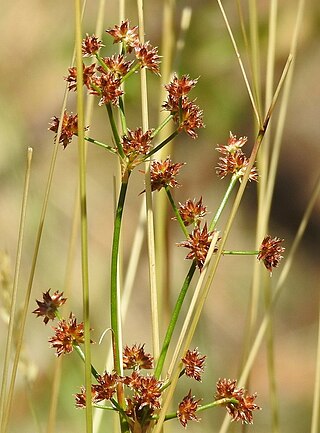
Juncaceae is a family of flowering plants, commonly known as the rush family. It consists of 8 genera and about 464 known species of slow-growing, rhizomatous, herbaceous monocotyledonous plants that may superficially resemble grasses and sedges. They often grow on infertile soils in a wide range of moisture conditions. The best-known and largest genus is Juncus. Most of the Juncus species grow exclusively in wetland habitats. A few rushes, such as Juncus bufonius are annuals, but most are perennials.

Juncus is a genus of monocotyledonous flowering plants, commonly known as rushes. It is the largest genus in the family Juncaceae, containing around 300 species.

Juncus effusus is a perennial herbaceous flowering plant species in the rush family Juncaceae, with the common names common rush or soft rush. In North America, the common name soft rush also refers to Juncus interior.

Teucrium chamaedrys, the wall germander, is a species of plant native to the Mediterranean regions of Europe and North Africa, and the Middle East as far as Iran. It is used as an ornamental.

Bellis annua, the annual daisy, is a small daisy species native to Mediterranean countries eastward to Iran.

Triteleia ixioides, known as prettyface or golden star, is a monocotyledon flowering plant in the genus Triteleia. It is native to northern and central California and southwestern Oregon, where it can be found in coastal and inland coniferous forests and other habitat. It is a perennial wildflower growing from a corm. It produces one to two basal leaves up to 50 centimeters long by 1.5 wide. The inflorescence arises on an erect stem up to 80 centimeters tall. It is an umbel-like cluster of several flowers each borne on a pedicel up to 7 centimeters long. The flowers are variable in size, measuring one to nearly three centimeters in length. They are pale to bright yellow, or sometimes purple-tinged white. There are six tepals with darker midveins in shades of green, brown, or purple. The lobes are funnel-shaped and may open flat or somewhat reflexed. The six stamens form a fused tube that protrudes from the corolla; they have broad, flat filaments and whitish, yellowish, or blue anthers.

Juncus acutus, the spiny rush, sharp rush or sharp-pointed rush, is a flowering plant in the monocot family Juncaceae. It is native to the Americas, Northern and Southern Africa, Western and Southern Europe and West Asia, and is found in a variety of wet habitats, such as bogs, fens, meadows, and salt marshes, and along the edges of ponds and lakes.

Juncus kraussii commonly known as salt marsh rush, sea rush, jointed rush, matting rush or dune slack rush, is of the monocot family Juncaceae and genus Juncus. It grows in salt marshes, estuarine and coastal areas.

Juncus acutiflorus, also called sharp-flowered rush, is a rush or a grassy plant of the genus Juncus. As the name suggests, the plant has notable sharp-looking flowers, flowering between July and September.

Solanum villosum, the hairy nightshade, red nightshade or woolly nightshade, is a sprawling annual weed in Europe, western Asia, northern Africa and is also naturalized in Australia and North America.
Iris spuria subsp. musulmanica is a species of the genus Iris, part of a subgenus known as Limniris and in the series Spuriae. It is a subspecies of Iris spuria and is a rhizomatous perennial plant, from Armenia, Azerbaijan, Iran and Turkey in Asia with flowers in various shades of blue, but there are rare white forms. They have a yellow centre and darker veining. It has the common name of 'Muslim iris'. It is cultivated as an ornamental plant in temperate regions.

Juncus dichotomus is a monocot in the Juncaceae family of rushes. The plant is native to the Americas in temperate zones but has been introduced to other parts of the world. Juncus dichotomus often is found in very moist areas and where rainfall is a common occurrence. It is often most recognizable in the spring and summer months due to its conspicuous flowers and infructescence.

Juncus compressus is a species of flowering plant in the rush family, Juncaceae. It is native to temperate Eurasia.Juncus compressus is easy to confuse with J. gerardii.

Juncus inflexus, the hard rush, is a species of flowering plant in the family Juncaceae, native to Europe, Asia and Africa, and introduced in Sri Lanka, Java, Île Amsterdam and Île Saint-Paul, Victoria in Australia, New Zealand, Uruguay, and eastern North America. It is a glycophyte (non-halophyte).

Anthemis cretica, the Cretian mat daisy or white mat chamomile, is a species of flowering plant in the family Asteraceae. It or its many subspecies can be found around the Mediterranean region, the Black Sea area, Poland, the Caucasus, and the Middle East as far as Iran. It is highly morphologically variable, and the namesake of a species complex.

Cyperus serotinus is a species of sedge that is native to parts of Europe and Asia.
Juncus minutulus is a species of rush (Juncaceae) informally referred to as minute rush, dwarf toad rush and annual rush.

Juncus fontanesii, also known as Desfontaines' rush, is a species of rush in the family Juncaceae.
Juncus littoralis is a species of rush in the family Juncaceae known as coastal rush; it has no subspecies.
Dryopteris pallida is a species of fern.






















